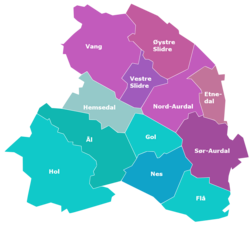Hallingdal
| Hallingdal | |
|---|---|
| District | |

Frå Hallingdal (Joachim Frich)
|
|
 Hallingdal
|
|
| Country | Norway |
| County | Buskerud |
| Region | Austlandet |
| Adm. Center | Nesbyen |
| Area | |
| • Total | 5,830 km2 (2,250 sq mi) |
| Population (2014) | |
| • Total | 20,569 |
| • Density | 3.5/km2 (9.1/sq mi) |
| Demonym(s) | Halling Hallingdøl is used by many outside the valley. |
Hallingdal (English: Halling Valley) is a valley as well as a traditional district located in Buskerud county in Norway. It consists of six municipalities: Flå, Nes, Gol, Hemsedal, Ål and Hol.
Hallingdal is one of the major valleys of eastern Norway, on an area of 5,830 square kilometers. Hallingdal lies in the northern part of the county of Buskerud. The valley stretches from Gulsvik by Lake Krøderen to the border with Hordaland and Sogn og Fjordane. Central to the geography is relatively flat mountain area which lies from 700 to 1100 meters above sea level. The valley is V-shaped and is drained by the Hallingdal River which originates in the western parts of Hardangervidda and flows eastwards later southwards through Hallingdal.
The Old Norse form of the name was Haddingjadalr. The first recorded case beginning with Hall- is from 1443. The first element seems to be the genitive case of the name of the people Haddingjar or of the male name Haddingi. In Flateyjarbók, a man named Haddingr is mentioned as the king of Hallingdal. Compare with the first element in Gudbrandsdalen 'Gudbrand Valley'. In both cases the name is probably derived from the word haddr, meaning 'woman's hair' and the name can consequently be interpreted as meaning 'the long haired ones'. The last element is dalr which means 'valley, dale'.
From early on, Hallingdal prospered from trading with iron, produced from local marshlands, and developed trading routes throughout the Iron Age. In later centuries, Hallingdal farmers traded cattle over the mountains from west to east. As the soil in the valley could be barren, trading was necessary for life support. Ancient routes went to western Norway (Vestlandet) through Valdres and Hallingdal and down Røldal to Odda. Reflecting this route, Hallingdal and its neighboring valley of Valdres were originally populated by migrants from Vestlandet and spoke a western dialect. The actual migration routes are hard to map, and the migrants may have blended with local hunters from the mountains around the valley. In recognition of this, Cardinal Nicholas Breakespear, (later Pope Adrian IV) who was in Scandinavia as papal legate in 1153, included these two valleys in the Diocese of Stavanger.
...
Wikipedia
